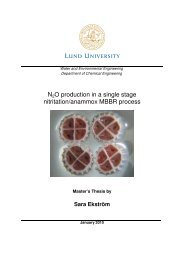Alexander Szabo and Oscar Engle - Svenskt Vatten
Alexander Szabo and Oscar Engle - Svenskt Vatten
Alexander Szabo and Oscar Engle - Svenskt Vatten
Create successful ePaper yourself
Turn your PDF publications into a flip-book with our unique Google optimized e-Paper software.
Figure 6.1: Map over the UTM campus area with (1) The WSP studied in this report (2) another<br />
WSP within UTM; (3) biological-mechanical treatment plant; (Another campus area <strong>and</strong> treatment<br />
plant is located in the north-east, outside the map) (<strong>Szabo</strong> & <strong>Engle</strong>, 2010)<br />
The treatment system that this report will focus on consists of two parallel lines of facultative<br />
ponds followed by maturation ponds (Figure 6.2). The available documents do not tell for how<br />
many persons the ponds are dimensioned for, but according to the contractor for de-sludging<br />
operation, this pond system was built to serve approximately a P.E. of around 8 000. The pond<br />
system is a simple construction, where the influent waste water is divided in a chamber before it<br />
enters each treatment line through pipes located under the water surface. The ponds have no<br />
screening <strong>and</strong> objects of many different sizes have been seen floating in the pond. These objects<br />
have a tendency to clog the cannels between the ponds. Since the water level of the receiving<br />
river is higher than the effluent level, a pumping station is located between the pond <strong>and</strong> the river.<br />
The pumps are currently working discontinuously, <strong>and</strong> during the time when the pumps are not<br />
pumping, the ponds accumulate waste water beyond the designed water levels. The technical data<br />
of the pond system can be found in Appendix G.<br />
Figure 6.2: Shape of pond system with facultative ponds (1) followed by maturation ponds (2)<br />
(<strong>Szabo</strong> & <strong>Engle</strong>, 2010).<br />
6.3 Recipient<br />
<br />
Introduction<br />
The effluent from the WSP is released into a stream passing through the UTM area (Figure 6.3).<br />
The stream transforms into two small lakes a few hundred meters downstream, where the main<br />
entrance to UTM is located (see Figure 6.4). In these small lakes, canoeing activities take place<br />
which dem<strong>and</strong>s good water quality. The part of water that origin from the WSP is large compared<br />
to the upstream river water. Most of the water in the lakes is therefore considered mainly to be<br />
effluent water from the WSP.<br />
<br />
28















